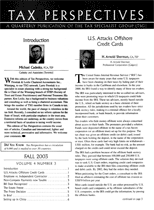
PDF Format
 Issue Contents Issue Contents
 All Issues All Issues
Fall 2003
Volume 3, Number 3
The information in Tax Perspectives is prepared for general interest only. Every effort has been made to ensure that the contents are accurate. However, professional advice should always be obtained before acting and TSG member firms cannot assume any liability for persons who act on the basis of information contained herein without professional advice.
The Proxy Decision
One of the more complex decisions to make in an SR&ED claim is in how to calculate overhead expenditures. The choices are filing a "Proxy Method" or a "Traditional Method" claim. Briefly, the Proxy Method allows for a gross-up of labour costs by 65% to cover overhead. The Traditional Method uses actual costs. The decision on which method to use must be considered before collecting data and compiling the file, as each method contains different elements and the data is assembled differently. Currently, the biggest difference in required data is in the labour area. If you are electing "Proxy", the labour cost is limited to those costs directly involved in the R&D effort (otherwise known as the "directly engaged rule"). An example of this is a chemical researcher who is actually holding the test tube and performing the test with his direct supervisor. The chemist is obviously directly involved but what about the supervisor? If a senior level person is involved in SR&ED, the challenge is to prove that that person directly supervised or performed the SR&ED. This example can be applied to any industry. This rule is not designed to eliminate the corporate president from the R&D claim if that is where the technical ideas come from, but how the person is involved must be clear. Further, if you are using the Proxy Method, the labour cost must be the net cost. This encompasses the R&D portion of all employee costs, with the exception of specified employees, who are employees who own more than 10% of the corporation. The net cost does not include benefits or bonus payments of specified employees. So why would you claim the Traditional Method? The 'directly engaged' rule is relaxed. This means that the R&D group admin person not directly involved in the R&D other than in a supporting role would now be eligible. Further, any person in the corporation whose efforts can be 'attributed' to the R&D effort is eligible. Examples of attributable staff would be purchasing, personnel, payroll and senior executives. In addition, benefits for specified employees are NOT excluded from the claim. The only remaining challenge is to attribute overhead in an acceptable manner. You may use a percentage of total factory floor space to attribute costs to a dedicated R&D lab. For example, the lab may cover 5,000 square feet of a 20,000 square foot factory, which would attribute 25% of overhead costs to the claim. Overhead expenditures and their attribution to R&D should be reviewed for overall reasonability. Regulation 2902, which contains a list of unallowable expenditures, must be reviewed before the R&D claim calculation can be considered complete. This list is extensive and contains, for example, rent, accounting and legal fees, capital depreciation costs, interest expense, penalties and certain membership fees. It is worth pointing out that in December 1992, when the proxy rule was first introduced, one of the chief reasons was to reduce audit time spent 'discussing' the various possible expenditures that may be included. CCRA will accept a traditional overhead claim but in the words of one senior official "it better not come out to 65%". In other words, there should be a dear reason overhead is higher than the Proxy Method. Few employees and many consultants or very high cost prototypes are reasons to claim the traditional overhead method. Generally though, the Proxy Method yields a higher tax credit claim in most cases
|